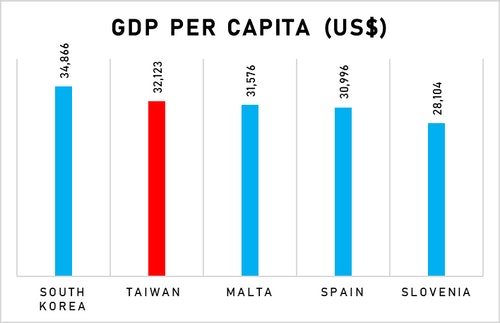
Taiwan’s GDP grew by 8.16% last quarter — its fastest rate in more than 10 years. According to the International Monetary Fund, Taiwan’s GDP per capita rose to US$32,123. Not only has it surpassed Spain’s GDP per capita (US$30,996), it has also nearly caught up with South Korea’s (US$34,866).

However, while Taiwan’s GDP per capita is escalating, wages have remained stagnant.
Taiwan now has a GDP per capita that sits in the league of South Korea and Spain, but its minimum wage continues to remain paltry. Below, I compare Taiwan with European Union countries and Asian Tigers with a similar GDP per capita — South Korea, Malta, Spain, and Slovenia.
Taiwan’s minimum wage is only NT$24,000 (US$853), as compared to NT$45,985 in South Korea, NT$37,427 in Spain, NT$34,587 in Slovenia, and NT$26,497 in Malta. In other words, Taiwan’s minimum wage is only half that of South Korea — even though Taiwan’s GDP per capita is almost on par. In fact, while Taiwan’s GDP per capita is higher than that of Spain and Slovenia, its minimum wage stands at only about two-thirds of the two countries.

Some observers argue that the comparisons need to be considered in terms of purchasing power parity (PPP). Taiwan is the richest among these countries by this measure. Indeed, Taiwan’s GDP per capita, calculated in terms of the World Bank’s PPP calculations, is $59,398, higher than South Korea ($47,027), Malta ($45,042), Spain ($41,546), and Slovenia ($40,820).

But again, what about wages?
If we calculate Taiwan’s minimum wage based on the ratio of PPP conversion, it continues to be one of the lowest.
Taiwan’s minimum wage in PPP (expressed in New Taiwan dollars) is only NT$44,378 as compared to South Korea’s NT$62,024, and lower than the NT$50,000 level that Slovenia and Spain’s minimum wages hover around.

The argument is that PPP allows us to measure the adequacy of wages to meet the cost of living. And while Taiwan’s GDP per capita on a PPP basis might be higher than these other countries, Taiwan’s minimum wage is actually lower. This suggests that on the whole, Taiwan is producing greater wealth than the other countries, but the wages returned to workers are lower.
In fact, if Taiwan is to have a minimum wage comparable to these other countries, Taiwan’s minimum wage should be about NT$27,100 (if pegged to Spain and Slovenia’s PPP) or NT$33,500 (if pegged to South Korea’s PPP).
As of 2019, close to a third of Taiwan’s workers earn less than NT$30,000.

The World Bank’s PPP calculations have been criticized for their methodology, such as making a country’s purchasing power appear higher by using lower prices than the norm for calculations.
An alternative measure is Numbeo’s Cost of Living Index, in which prices are based on actual user consumption. Accordingly, if Taiwan’s minimum wage is to match the wage-to-cost of living ratio of the other countries, the minimum wage should be around NT$41,300 (if pegged to Spain), NT$38,000 (if pegged to Slovenia) or NT$36,950 (if pegged to South Korea).

Half of Taiwan’s workers earn less than NT$40,000.
Moreover, 90% of Taiwan’s workers earn less than NT$72,800 — which is actually lower than the median wage in both South Korea and Spain, or what the workers in the 50th percentile earn in these countries. Also, the median-wage worker in Slovenia earns more than 70% of Taiwan’s workers.
One reason why Taiwan’s wages are so low is because they take a low share in the country’s GDP. According to Taiwan’s Directorate General of Budget, Accounting, and Statistics, Taiwan’s wage share is only 46.03%, while according to the United Nations, it is 53.8% in South Korea, and an even higher 58.4% in Slovenia and 61.2% in Spain.

In other words, of the wealth that Taiwan’s workers have generated for the economy, a relatively low proportion is returned to them.
With Taiwan’s GDP per capita having caught up with South Korea, Taiwanese companies on average are earning higher dollar profits than their South Korean counterparts by paying workers lower wages.
This means that Taiwan’s bosses are richer on average than South Koreans bosses, while Taiwanese workers are poorer than South Korean workers. The disparity is even wider when taking into account the differences in cost of living between the two countries.
Taiwan’s low wages relative to the high profits of businesses explain why Taiwan’s wealth inequality is the highest among these countries: 75.1% (a higher number reflects greater wealth inequality, where a larger share of the country’s wealth is concentrated among a select few), as compared to 60.6% in South Korea, 66.2% in Slovenia, 64.0% in Malta, and 69.4% in Spain.

Profits remain excessively high largely due to the power of business in determining the government’s priorities, which have continuously allowed costs, including wages, in Taiwan to be held back, on the pretext of creating growth.
While wages have been held back, profits have not. In fact, prices have not been kept low, either. According to Numbeo, Taiwan’s cost of living is higher than both Spain and Slovenia, even as Taiwan’s wages are lower. Taiwan’s cost of living is midway to that of Canada, Germany, the United Kingdom and the United States, and yet the U.S. is debating increasing the minimum wage to US$15 (NT$420) an hour, while Taiwan is still stuck at NT$160, or only just above a third of the U.S. figure. Germany’s minimum wage is €1,614 (NT$54,500) per month, or more than twice that of Taiwan’s.
While Taiwan’s GDP per capita has grown on the back of profits and increasing prices, the wages of workers have remained stagnant.
Can you imagine how much higher Taiwan’s GDP per capita would be if workers were paid higher wages, had greater spending power, and were able to use their consumption to drive growth in Taiwan? What’s the point of Taiwan’s GDP growth if workers don’t actually benefit from it? Yet, businesses complain about the low domestic consumption — as if they are not at all responsible for the situation.
In fairness, the central bank has played a role in suppressing the economic power of workers. Lin Hsin-yi, professor at the Department of Economics of National Chengchi University, explained that while Taiwan’s low interest rates since the early 2000s were intended to encourage private-sector investment, the persistently low interest rates have instead produced the opposite effect. Investment in machines and equipment have dwindled while investment in real estate has soared, creating “zombie companies,” or what financial journalist Mike Bird has called a “lopsided” economy.
It doesn’t have to be this way. In electronics manufacturing, Taiwan continues to perform well in upstream manufacturing (or the production of intermediate goods) but performs poorly in downstream manufacturing (or the production of final products). South Korea, however, excels in both. Taiwan also ranks poorly in terms of the breakthrough capabilities of its innovations and patent value. Again, South Korea performs among the best.
Taiwan’s low cost model isn’t just dragging down workers and their wages. It is also dragging down innovation and Taiwan’s potential. Taiwan cannot just rely on the semiconductor industry for growth. It needs to rely on other sources of innovation — like by empowering workers with higher wages to do so.
So while Taiwan might celebrate high GDP growth, it’s appropriate to ask, “Cui bono?” — Who benefits? While companies earn more and the politicians get kickbacks, Taiwan’s workers are left to live on the bare minimum to sustain themselves.
Now that Taiwan’s GDP per capita has caught up with other countries of a similar GDP per capita, it has become obvious that Taiwan’s wages are low not because of a low cost of living.
The reason Taiwan’s wages are low is because there simply isn’t enough political pressure to increase wages, and a segment of politicians who are too willing to be persuaded to align with business interests. Taiwan moreover ranked at a higher 10th on The Economist’s Crony Capitalism Index, as compared to South Korea’s 21st (out of 22 countries ranked). Taiwan was the second worst-performing advanced economy.
Now that Taiwan’s GDP per capita has grown to the level of South Korea and Spain, will Taiwan’s government raise the minimum wage to a similar level (NT$37,000 to NT$56,000)? Or will it keep boasting about GDP growth even though it means little for workers?
The fault lies primarily with the government for not implementing a minimum wage that is aligned to the basic living needs of citizens. If the current ruling Democratic Progressive Party (DPP) does not take this issue seriously, they leave the door open for the Taiwan People’s Party (TPP) to take advantage and draw away more votes. Just last month, TPP legislator Lai Hsiang-ling called on the government to raise the minimum wage, pointing to the 48% of artists who earn less than NT$30,000 a month.
If Taiwan’s government is serious about protecting Taiwan’s independence, empowering Taiwanese with higher wages is a no brainer. Workers who feel valued are more likely to give back to their country. A good first step is heeding the calls of labor rights groups advocating for an increase of the minimum wage to NT$30,000, which is long overdue.
It’s time to give back to workers, especially when the economy is roaring ahead — on the backs of their efforts.
READ NEXT: Taiwan’s Rigged Economy Dampens Innovation
TNL Editor: Bryan Chou, Nicholas Haggerty (@thenewslensintl)
If you enjoyed this article and want to receive more story updates in your news feed, please be sure to follow our Facebook.







